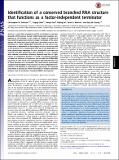| dc.contributor.author | Yuqing, Chen | |
| dc.contributor.author | Ke, Ailong | |
| dc.contributor.author | Weaver, Keith E. | |
| dc.contributor.author | Dunny, Gary M. | |
| dc.contributor.author | Johnson, Christopher M | |
| dc.contributor.author | Lee, Heejin, 1976- | |
| dc.date.accessioned | 2014-11-04T15:26:23Z | |
| dc.date.available | 2014-11-04T15:26:23Z | |
| dc.date.issued | 2014-02 | |
| dc.date.submitted | 2013-08 | |
| dc.identifier.issn | 0027-8424 | |
| dc.identifier.issn | 1091-6490 | |
| dc.identifier.uri | http://hdl.handle.net/1721.1/91285 | |
| dc.description.abstract | Anti-Q is a small RNA encoded on pCF10, an antibiotic resistance plasmid of Enterococcus faecalis, which negatively regulates conjugation of the plasmid. In this study we sought to understand how Anti-Q is generated relative to larger transcripts of the same operon. We found that Anti-Q folds into a branched structure that functions as a factor-independent terminator. In vitro and in vivo, termination is dependent on the integrity of this structure as well as the presence of a 3′ polyuridine tract, but is not dependent on other downstream sequences. In vitro, terminated transcripts are released from RNA polymerase after synthesis. In vivo, a mutant with reduced termination efficiency demonstrated loss of tight control of conjugation function. A search of bacterial genomes revealed the presence of sequences that encode Anti-Q–like RNA structures. In vitro and in vivo experiments demonstrated that one of these functions as a terminator. This work reveals a previously unappreciated flexibility in the structure of factor-independent terminators and identifies a mechanism for generation of functional small RNAs; it should also inform annotation of bacterial sequence features, such as terminators, functional sRNAs, and operons. | en_US |
| dc.language.iso | en_US | |
| dc.publisher | National Academy of Sciences (U.S.) | en_US |
| dc.relation.isversionof | http://dx.doi.org/10.1073/pnas.1315374111 | en_US |
| dc.rights | Article is made available in accordance with the publisher's policy and may be subject to US copyright law. Please refer to the publisher's site for terms of use. | en_US |
| dc.source | PNAS | en_US |
| dc.title | Identification of a conserved branched RNA structure that functions as a factor-independent terminator | en_US |
| dc.type | Article | en_US |
| dc.identifier.citation | Johnson, Christopher M., Yuqing Chen, Heejin Lee, Ailong Ke, Keith E. Weaver, and Gary M. Dunny. “Identification of a Conserved Branched RNA Structure That Functions as a Factor-Independent Terminator.” Proceedings of the National Academy of Sciences 111, no. 9 (February 18, 2014): 3573–3578. | en_US |
| dc.contributor.department | Massachusetts Institute of Technology. Department of Biology | en_US |
| dc.contributor.mitauthor | Johnson, Christopher M. | en_US |
| dc.relation.journal | Proceedings of the National Academy of Sciences | en_US |
| dc.eprint.version | Final published version | en_US |
| dc.type.uri | http://purl.org/eprint/type/JournalArticle | en_US |
| eprint.status | http://purl.org/eprint/status/PeerReviewed | en_US |
| dspace.orderedauthors | Johnson, Christopher M.; Chen, Yuqing; Lee, Heejin; Ke, Ailong; Weaver, Keith E.; Dunny, Gary M. | en_US |
| dc.identifier.orcid | https://orcid.org/0000-0002-2298-7462 | |
| mit.license | PUBLISHER_POLICY | en_US |
| mit.metadata.status | Complete | |
